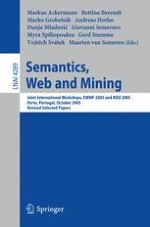Finding knowledge – or meaning – in data is the goal of every knowledge d- covery e?ort. Subsequent goals and questions regarding this knowledge di?er amongknowledgediscovery(KD) projectsandapproaches. Onecentralquestion is whether and to what extent the meaning extracted from the data is expressed in a formal way that allows not only humans but also machines to understand and re-use it, i. e. , whether the semantics are formal semantics. Conversely, the input to KD processes di?ers between KD projects and approaches. One central questioniswhetherthebackgroundknowledge,businessunderstanding,etc. that the analyst employs to improve the results of KD is a set of natural-language statements, a theory in a formal language, or somewhere in between. Also, the data that are being mined can be more or less structured and/or accompanied by formal semantics. These questions must be asked in every KD e?ort. Nowhere may they be more pertinent, however, than in KD from Web data (“Web mining”). This is due especially to the vast amounts and heterogeneity of data and ba- ground knowledge available for Web mining (content, link structure, and - age), and to the re-use of background knowledge and KD results over the Web as a global knowledge repository and activity space. In addition, the (Sem- tic) Web can serve as a publishing space for the results of knowledge discovery from other resources, especially if the whole process is underpinned by common ontologies.
